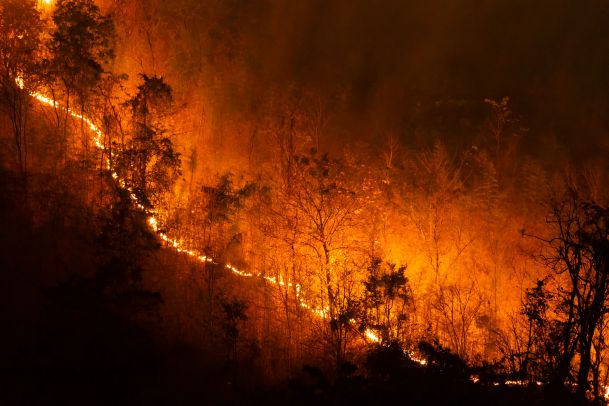
Written by Kayla Jane Barrie Sep 23, 2025 5 mins read

Most home insurance policies, even basic ones, cover fire damage, including that caused by natural disasters, such as wildfires.
Coverage typically includes rebuilding or repairing your home and outbuildings, replacing damaged belongings (though high-value items may require separate coverage), and covering temporary living expenses during repairs or evacuations.
Wildfire damage is generally covered by home insurance in two key ways: dwelling coverage protects your home's structure (including garage and other permanent buildings) and covers repair or rebuilding costs, plus additional living expenses if you need to relocate. Personal property coverage protects your belongings (furniture, clothing, electronics, etc.) from damage or destruction.
Remember to check your policy for exclusions and limitations, and consider documenting your possessions with photos and a list for easier claims processing.
Insurance companies may temporarily restrict new policy sales and coverage changes in areas facing immediate wildfire threats, though existing renewals remain unaffected. A Declaration of Emergency Endorsement in many policies extends coverage for 120 days if renewal is delayed due to an emergency.
Because insurance protects against unforeseen events, securing year-round coverage is crucial, rather than waiting until a threat emerges. Temporary restrictions may include halting new policies, altering deductibles or coverage limits, and preventing major policy changes; these restrictions are lifted as the threat subsides.
Whether your home insurance premiums will increase after a wildfire depends on several factors. If your home sustained damage and you filed a claim, it's highly likely your premiums will increase. Insurers assess risk, and a claim, especially a large one, indicates a higher risk of future claims.
Even if your home wasn't directly damaged, if the wildfire significantly impacted your area (increased risk of future fires), your premiums might still go up because your insurer now sees your property as being in a higher-risk zone. The extent of the premium increase will depend on your insurer, the specifics of your claim (if any), and the overall assessment of the risk in your area.
Coverage details depend on your specific policy; contact your insurance representative for clarification.
Homeowner's policies typically offer replacement cost coverage up to your policy limit. Some policies offer guaranteed replacement cost, covering all repair or rebuilding expenses, even exceeding the policy limit (usually with a "same site" rebuild requirement).
Fire insurance rates are determined by assessing the risk of fire damage to your property. Key factors include:
Tenant insurance doesn't directly cover damage to the building itself caused by a wildfire; that's the landlord's responsibility. However, it does typically cover the loss or damage to your personal belongings caused by a wildfire and may also cover additional living expenses if you're displaced due to the fire. The specifics depend on your policy and its coverage limits.
If you need to file a home insurance claim related to wildfire damage, here are some tips:
While you can't always predict a fire, taking proactive steps can significantly reduce the risk and impact. Here are some tips:
Here is an overview of the most recent wildfire statistics across Canada.
For up-to-date information on Canadian wildfires, check the daily maps from the Canadian Wildland Fire Information System and the Canadian Interagency Forest Fire Centre (CIFFC) during the fire season.
Your home and business insurance covers fire damage, regardless of cause, unless the fire was intentionally set by you.
While many insurers recommend fire and smoke remediation contractors they trust, you're free to choose any provider for repairs. Insurers may even guarantee the work of their recommended contractors, but using one isn't mandatory.
Getting fire insurance may be impossible if a wildfire is burning nearby. Insurance provides long-term protection, not immediate relief from existing threats. Wildfires within approximately 50 kilometers typically make a property too risky to insure until the danger passes. This also applies to adding coverage during renewal. You can't get coverage for a threat that's already present. Securing adequate home insurance before a wildfire risk arises is crucial.
It’s important to understand your home insurance coverage for wildfires, especially with the increasing frequency and intensity of these natural disasters. While most standard home insurance policies offer protection for your dwelling and personal property, and cover additional living expenses, it's vital to review your specific policy for any limitations or exclusions.
Taking proactive measures to mitigate fire risks and documenting your possessions can further safeguard your home and ensure a smoother claims process. Stay informed, stay prepared, and contact ThinkInsure for an Ontario home insurance quote.
| Categories | Home |
|---|---|
| Tags | Protect Your HomeHomeowners ClaimsHome Coverage |
Read our insurance blog to get helpful tips, information and news.
Drive safe this winter! Check out these tips for driving in snowy and icy conditions in Ontario. Get other helpful info and FAQs on winter driving.
Drive safer this winter. Learn how the right set of winter tires drastically reduces stopping distance and risk on ice and snow. Get expert tips from your trusted insurance provider.
Ontario municipalities have until November 14 to remove all automated speed enforcement cameras following fast-tracked provincial legislation. This post breaks down why the government is removing them, the pushback from road safety advocates, and what alternative measures will replace them.
What is specified perils insurance coverage? Learn about named perils policies for Ontario drivers. Get info about coverage, if you need it & answers to common questions.